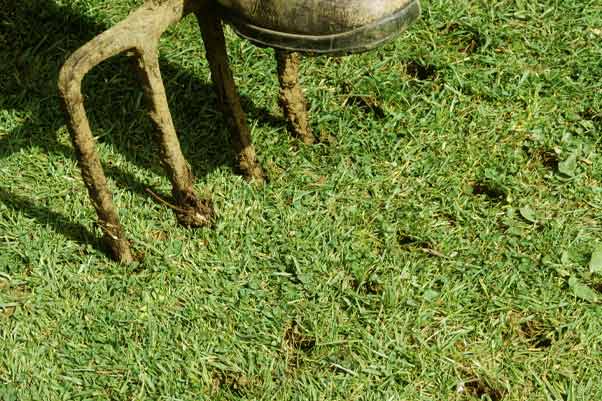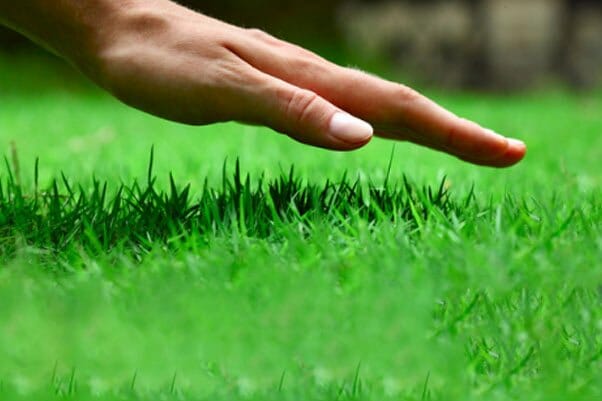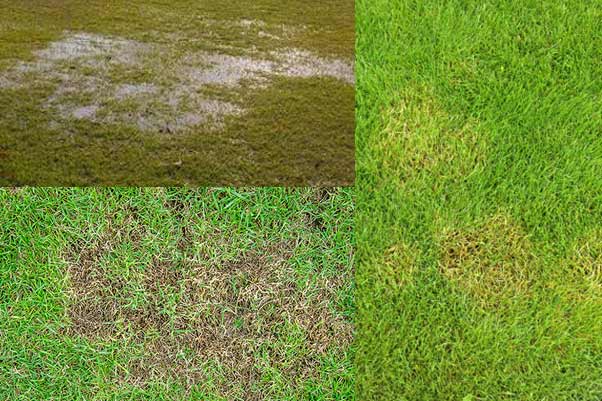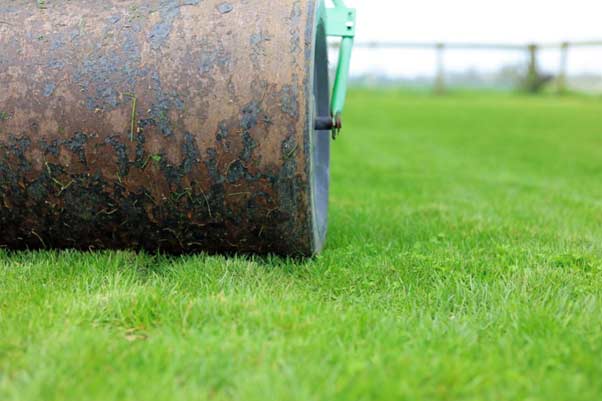Lawn aeration involves creating holes in your lawn by either using a core or spiking technique.
Lawn aeration allows oxygen to the roots of your lawn which stimulates root growth, leading to a greener and healthier lawn. Lawn aeration also allows water and nutrients to get to the roots of compacted soil.
How often you should aerate and when is the best time to aerate will depend on where you live and the type of soil you have. Let’s take a closer look at how to get the maximum benefits from lawn aeration.
What we cover
ToggleWhat is lawn aeration?

Lawn aeration refers to the process of punching holes in your lawn to assist the movement of air, water, and other nutrients needed for the healthy growth of your lawn.
Aerating the lawn:
- Creates room for the grasses roots to flourish
- Allows the roots to grow stronger and deeper into the soil
- Provides your soil and grass with an easy movement of air and breathability
- Increases the movement of water, oxygen, and other nutrients in the soil
- Prevents thatch accumulation
- Improves the water absorption rate of your lawn soil after irrigation or rainfall
What do you do after you aerate your lawn?
To fully enjoy lawn aeration benefits, you need to do the following after aerating your lawn.
- Fertilizer Application: Apply fertilizer to the soil immediately after aeration. It fills your soil with nutrients to feed the roots of your lawn grass.
- Ignore the Holes: The gaping holes left behind by aerating the lawn may irk you at first, but best to leave them alone. The holes will be filled with new roots within a few weeks.
- Lawn Watering: The lawn may become dry after aeration. Water your lawn heavily after aerating to encourage deeper grass root growth. Heavy watering helps after aeration improves the growth of your lawn grass.
How often should you aerate your lawn?
The lawn aeration frequency is affected by grass type, soil type, and how often the lawn is used. Ideally, lawn aeration should be done once a year, but a lawn that experiences heavy use may need to be aerated twice in one year.
The best times to aerate your lawns are dependent on the grass type you have. For cool-season lawn grass, aeration is best done in the spring or fall. For warm-season lawn grass, aeration is best done in the summer.
Does aeration help level the lawn?
Lawn aeration does help to level your lawn. Without aeration, compacted soil can form hills and valleys that can not be changed unless given room to move. By punching holes in the lawn, the soil will naturally settle and level out.
Do I need to aerate my lawn?

While lawn aeration is a great maintenance exercise for healthy lawns, not every lawn needs to be aerated. For example lawns with really sandy soils will not need aeration as often.
If you are not convinced about aerating your lawn, here are some of the signs of a lawn needing aeration.
- Poor lawn grass growth despite watering the lawn adequately.
- The lawn grass feels lithe to the touch and loses water quickly.
- The lawn experiences heavy use and traffic.
- Your lawn is layered with soil. Soil layering impedes water flow into the ground, leading to compacted lawn soil and weak root growth.
Can you walk on the lawn after aeration?
After aerating your lawn successfully, part of the activities to carry out on your lawn is to reseed the lawn grass and water heavily.
Lawn aeration does not stop you from walking on your lawn. However, do not put your aeration and reseeding efforts to waste, reduce the frequency of walks on the lawn and lawn use.
Movement should be limited until the new grass is grown and ready for mowing. At this point, you can resume your normal lawn activities without fear.
Can you aerate too much?
How often you need to aerate your lawn is dependent mainly on the soil type. Ideally, the lawn should be aerated once a year to three years. If your lawn contains loose soil and experiences healthy grass growth, it does not need to be regularly aerated.
The presence of thick soil that traps water easily will need frequent lawn aeration. Irrespective of the soil type, aerating the lawn should be done once a year and twice for thick soil lawns or heavy-use lawns.
Aerating your lawn more than necessary can damage your lawn grass and create a growth imbalance.
Should I roll my lawn after aerating?
Lawn rolling does the exact opposite of lawn aeration. Lawn rolling squeezes out excess water from the soil and compacts the lawn soil. If you are rolling the lawn immediately after aeration, then you have defeated the purpose of aerating the soil in the first place.
The goal of lawn aeration is to reduce soil compaction, and make water, air, and other essential nutrients easily accessible to your lawn grass. Healthy lawn grass is dependent on these factors.
If you are looking to level out your lawn, I suggest adding some topsoil with an 80:20 mix of sand and soil to help fill in the valleys and divots.
What month Should I aerate my lawn?
As mentioned above, the best time to aerate your lawn is dependent on the type of grass you are growing.
Cool-season lawn grass is best aerated in April (Spring) before pesticide application and in September (Fall) ahead of overseeding.
Warm-season lawn grass is best aerated when the grass is growing – in the months of May and July.
Cool-season lawn grasses grow well in cold weather conditions like spring and fall. They grow and thrive, no matter how cold it gets.
Warm-season lawn grasses are tropical grass types that thrive in hot weather conditions.
Most of the growth is done in the summer, and the grasses become dormant during cold weather conditions like winter.
FAQ's
How do I know if my lawn needs aeration?

Not every lawn will need aeration, but some visible signs will point to the fact that you should aerate your lawn.
Some signs your lawn needs aeration are:
- Puddles of water that can not soak in
- Bare patches where grass will not grow
- Discolored patches of grass
Should I pick up plugs after aerating?
It is very tempting to pick up soil plugs after aerating the lawn. Please don’t do it! The lumps of soil will remain on your lawn after aeration, but they will dissolve and disappear into the soil with time.
As the plugs dry up, they filter back into the soil slowly while acting as natural fertilizers for the lawn. When you remove the plugs after aeration, you reduce the nutrients available to your lawn grass. You also cut short the essential nutrients and microorganisms they supply to the soil.
Picking up plugs after lawn aeration could lead to dieback or browning brought about by turf stress.
Is rolling your lawn good or bad?

Lawn rolling is believed to help level bumpy and uneven lawns. Lawn rolling will not help much when it comes to lawn leveling because it does not help flatten high areas on your lawn. Rolling will achieve about a half-inch flattening of the soil with no filling effect on the low areas.
Rolling leads to soil compaction, which you should avoid for your lawn because soil compaction does not aid healthy lawn growth.
Instead of rolling, lawn aeration is better and healthier for your lawn. Lawn aeration helps to fix bumpy lawns and levels your uneven lawn. Besides, you will be giving your lawn grass a healthy soil to thrive in via the space created for nutrients, air, and water to become easily accessible to the grass.






